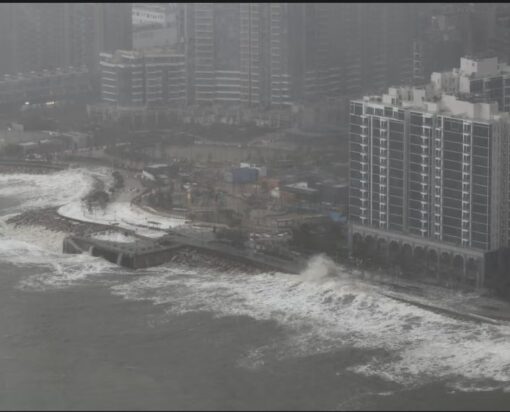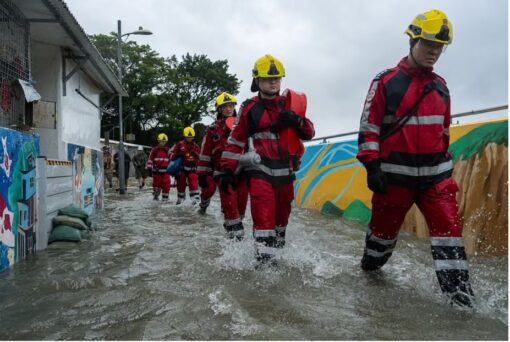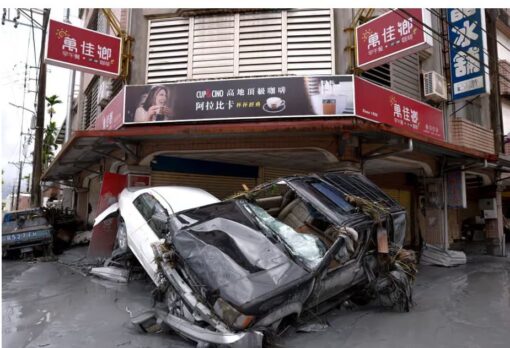The full force of Typhoon Ragasa has descended on Southern China, triggering the evacuation of more than two million residents across Guangdong, Guangxi, and Hainan provinces as the storm barrels inland after leaving a deadly trail across Taiwan and the Philippines.
What began as a distant weather system now stands as one of the most powerful storms to hit the region in recent years, with winds surpassing 150 kilometers per hour and heavy rain turning coastal towns into flood zones overnight.
Local authorities described the evacuation as the largest in nearly a decade, underscoring the severity of the threat facing communities along the southern seaboard.
Buses and military vehicles filled highways as families carried small bundles of belongings, some clutching bags of rice or bedding while others held tight to children and elderly relatives.

In Guangdong, where cities such as Zhanjiang and Maoming are in Ragasa’s direct path, shelters have been set up in schools, sports halls, and government buildings.
“We were told we could not stay in our homes, the winds are too strong and the roofs will not hold,” said a 56-year-old resident of Leizhou who left her village with her grandchildren before dawn. “It is frightening, but at least we are together.”
The Chinese Meteorological Administration issued its highest-level red alert, warning of torrential rain, landslides, and dangerous sea surges as Ragasa makes landfall again.
Fishing fleets have been ordered to return to port and thousands of coastal businesses shuttered their doors, boarding up windows and stacking sandbags against doorways.
Ferry services to Hainan Island were suspended on Tuesday night, stranding hundreds of passengers on both sides of the Qiongzhou Strait.
Train operators in Guangxi canceled dozens of long-distance services, while at least 700 flights were grounded in Guangzhou, Shenzhen, and Haikou.
“Safety of passengers is the absolute priority,” said a civil aviation official, acknowledging widespread frustration from travelers but urging compliance with emergency orders.
In Hainan, where Ragasa’s winds whipped through palm groves and flooded coastal markets, the evacuation reached nearly half a million people.
Farmers rushed to secure livestock, moving pigs and chickens to higher ground while trying to salvage crops already damaged by saltwater flooding. The province’s tourism-dependent economy has also taken a hit, with beach resorts along Sanya and Wanning deserted in what should be a busy travel season.
“Our hotel has closed for the week, all the guests left yesterday,” said a hotel manager in Sanya. “We are worried about the financial loss, but nothing is more important than staying alive.”
The storm’s scale is testing the resilience of emergency systems built after previous disasters. More than 100,000 rescue personnel, including soldiers, police, and medical teams, have been mobilized with helicopters and amphibious vehicles on standby.

Temporary power stations have been dispatched to areas most likely to suffer blackouts, while medical tents were erected in several counties. Still, officials admitted that the sheer scope of Ragasa’s rainfall—expected to dump more than 500 millimeters in parts of Guangdong and Guangxi—would overwhelm drainage systems.
“We cannot underestimate the threat of secondary disasters such as floods and landslides,” warned an emergency management spokesperson in Beijing. “Our priority is to ensure people are evacuated early and supported in safe shelters.”
For the millions now living in makeshift centers, daily life has been reduced to waiting. Families huddle on mats, children play with improvised toys, and loudspeakers broadcast updates about the storm’s movements.
Food distribution has begun in larger shelters, though reports suggest smaller rural centers are struggling to provide adequate supplies. A volunteer in Guangxi described long lines for bottled water and instant noodles.
“Most people are patient, they know this is necessary,” he said. “But if the storm lasts for days, shortages will be hard to avoid.”
The economic cost of Typhoon Ragasa is already being calculated. Major shipping lanes through the South China Sea have been disrupted, delaying cargo bound for international markets.
Pearl River Delta factories reported halting production, while rice fields in Guangxi faced catastrophic flooding just weeks before harvest. Economists predict losses in the billions, with ripple effects across industries from agriculture to electronics. Local officials acknowledged the hardship but promised rapid recovery efforts once the storm subsides.
Ragasa’s destructive path highlights how vulnerable the region remains to climate extremes. Earlier this week the typhoon battered the Philippines, leaving dozens dead and thousands displaced, before crossing into Taiwan where landslides swept through mountain towns.
Hong Kong endured gale-force winds and flash floods, but the damage there was less severe than feared thanks to reinforced infrastructure. Still, for many residents in Southern China, seeing the storm’s earlier devastation only heightened the urgency to leave.
“When I saw what happened in Taiwan, I knew we had to go,” said a migrant worker in Zhanjiang, who carried his mother on his back to an evacuation bus. “You cannot fight nature, you can only try to stay alive.”
International concern has grown as images of flooded streets and chaotic evacuations circulate online.
Foreign governments issued travel warnings for southern provinces, while humanitarian organizations offered support for post-storm recovery. China’s foreign ministry said it welcomed assistance but insisted that the government had adequate resources to protect its citizens.
At the same time, meteorologists warned that Ragasa could remain dangerous even as it weakens inland, bringing torrential rain as far north as Hunan and Jiangxi. “This storm is not just about the coast,” one forecaster cautioned. “It will continue to pour water into river systems already at breaking point.”
Despite the upheaval, moments of resilience shine through. In Hainan, volunteers organized games for children to distract them from the storm’s howling winds outside the shelter.

In Guangdong, an elderly man played a traditional string instrument to comfort evacuees, drawing applause from the crowd. “We cannot stop the typhoon, but we can support each other,” he said with a smile.
As Typhoon Ragasa presses deeper into Southern China, its power remains a reminder of the fragility of human settlements against extreme weather.
The storm has already etched itself into the memory of millions, not only as a destructive force but as a test of endurance and solidarity.
Whether the coming days bring greater devastation or a gradual easing of danger, the people forced from their homes now wait in anxious anticipation, hoping that when they return, their communities will still be standing.


